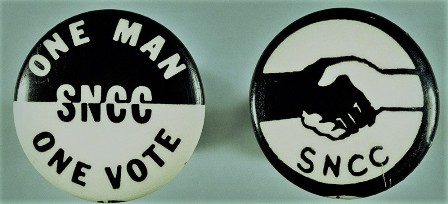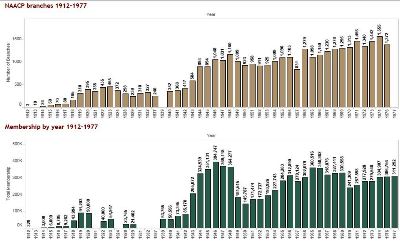SNCC History and Geography
Founded in April 1960 shortly after students at North Carolina A&T began the lunch counter sit-in campaign that reignited the southern civil rights movement, the Student Nonviolent Coordinating Committee was arguably the most dynamic and influential of the 1960s new left and civil rights era organizations. Not only did SNCC lead many of the campaigns that challenged segregation in the early 1960s, it also inspired some of the new radical formations of the mid and late 1960s, including Black Power and the student movements that swept across college campuses.
Here we explore the history and geography of this seminal organization with (1) interactive maps, charts, and lists that show more than 500 SNCC sit-ins, boycotts, and other actions from 1960 to 1970; (2) a yearbook/ database of SNCC actions; (3) a brief year-by-year history.
|
Here are maps and charts showing the year-by year and month-by-month actions of SNCC chapters. Filter by state and type of action.. |
|
This filterable database shows more than 500 SNCC actions month by month and by state.
|
|
In this collaborative essay, the SNCC project team (Hannah Wise, Jiajun Law, Kenon Morgan, Gary Chen, Brittany Lasher, Rachel Caldwell, Oliver Groeneveld, An Lau) detail the history of SNCC activism.
|
Additional Black Freedom Movements maps and charts
|
|
From an early date, the NAACP was a grass roots organization with a membership that expanded across the nation. These interactive maps and charts show the growth of the NAACP from a single branch with a few members in New York City to 80 branches by 1917, to 400 branches in 1923, then surging to more than 1,000 branches and 300,000 members during World War II, and then the regional surge into the South in the 1950s and 1960s. |
|
Founded by black and white students at the University of Chicago, the Congress of Racial Equality pioneered key tactics of the modern civil rights movement. Here we map more than 600 demonstrations organized by CORE and show the changing activist geography as the organization first attacked segregation in northern cities, then moved south sponsoring Freedom Rides and other forms of civil disobedience. |
|
Founded in Oakland, the Black Panther authorized only 12 additional chapters. Still the Party stages actions across a wider geography. Here are maps and timelines showing more than 500 BPP actions. In addition we show in detail the six metropolitan areas where the Panthers enrolled that largest number of members and made the greatest impact: Oakland-SF Bay Area; New York; Chicago; Los Angeles; Seattle; Philadelphia. |



